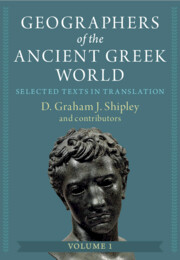Book contents
- Frontmatter
- Dedication
- Epigraph
- Contents
- List of Figures
- List of Maps
- List of Tables
- Contributors
- Preface
- Glossary
- Abbreviations
- Introduction: Greek Geography and Geographers
- Time-line
- Prologue: The Homeric Catalogue of Ships (Iliad, 2. 484–760)
- Part I Archaic Period
- Part II Classical Period
- Part III Hellenistic Period
- 9 Dikaiarchos of Messana
- 10 Timosthenes of Rhodes
- 11 Herakleides Kritikos
- 12 Eratosthenes of Kyrene
- 13 Mnaseas of Patara
- 14 Skymnos of Chios
- 15 Agatharchides of Knidos, On the Erythraian Sea
- 16 Hipparchos of Nikaia
- 17 The Nikomedean Periodos [‘Pseudo-Skymnos’]
- 18 Artemidoros of Ephesos
- 19 Poseidonios of Apameia
- 20 Dionysios son of Kalliphon
10 - Timosthenes of Rhodes
from Part III - Hellenistic Period
Published online by Cambridge University Press: 25 March 2024
- Frontmatter
- Dedication
- Epigraph
- Contents
- List of Figures
- List of Maps
- List of Tables
- Contributors
- Preface
- Glossary
- Abbreviations
- Introduction: Greek Geography and Geographers
- Time-line
- Prologue: The Homeric Catalogue of Ships (Iliad, 2. 484–760)
- Part I Archaic Period
- Part II Classical Period
- Part III Hellenistic Period
- 9 Dikaiarchos of Messana
- 10 Timosthenes of Rhodes
- 11 Herakleides Kritikos
- 12 Eratosthenes of Kyrene
- 13 Mnaseas of Patara
- 14 Skymnos of Chios
- 15 Agatharchides of Knidos, On the Erythraian Sea
- 16 Hipparchos of Nikaia
- 17 The Nikomedean Periodos [‘Pseudo-Skymnos’]
- 18 Artemidoros of Ephesos
- 19 Poseidonios of Apameia
- 20 Dionysios son of Kalliphon
Summary
This chapter presents new, annotated translations of the testimonia and fragments of Timosthenes of Rhodes (active 282–246 BC), arranged as 37 extracts. An appendix contains a new translation of Aristotle’s discussion of the winds at Meteorologika, 2. 6. The chapter introduction addresses the difficulty of linking references to Timosthenes to the various book titles of which we have reports, but argues that we should not automatically divorce him from the Timosthenes who wrote about the Pythian Melody of Delphi. His distinctive contribution to geography was in assembling detailed navigational data, particularly specific local topography useful to ship-captains. Typically of literary writers, however, he enlivened his technical material with information about local cultures. His legacy was considerable, probably visible, for example, in the Roman-period Stadiasmos (Chapter 31 of this volume).
Keywords
- Type
- Chapter
- Information
- Geographers of the Ancient Greek WorldSelected Texts in Translation, pp. 258 - 274Publisher: Cambridge University PressPrint publication year: 2024

